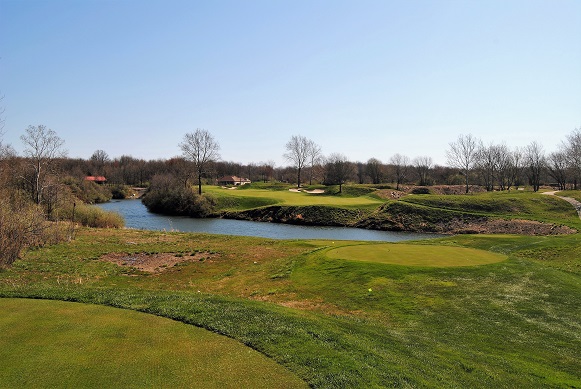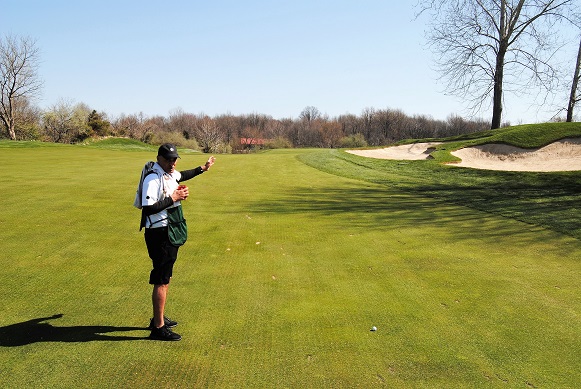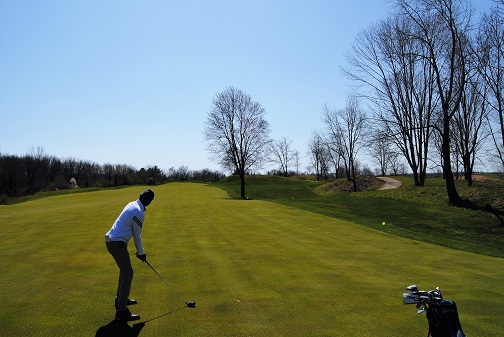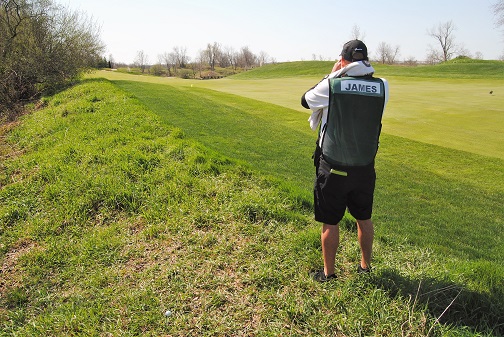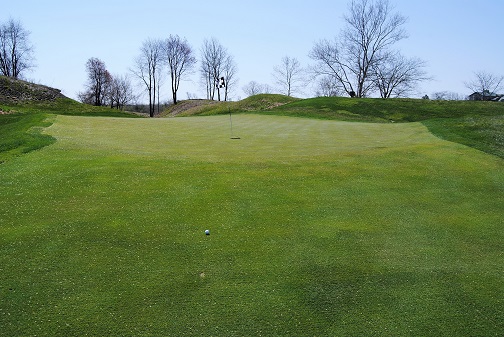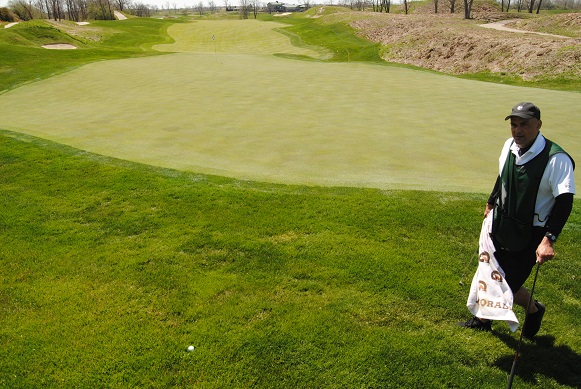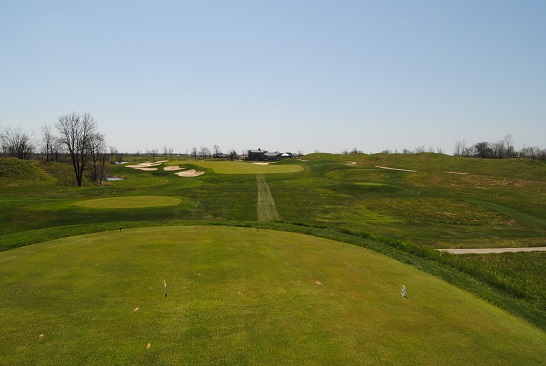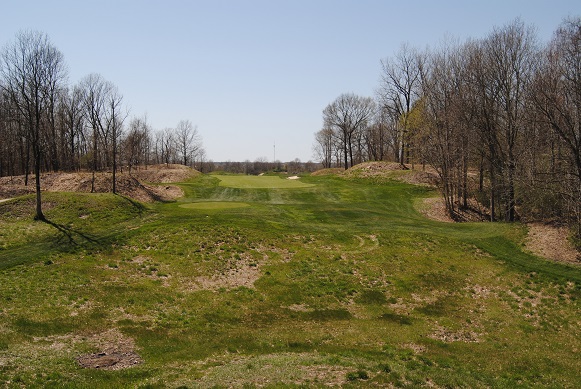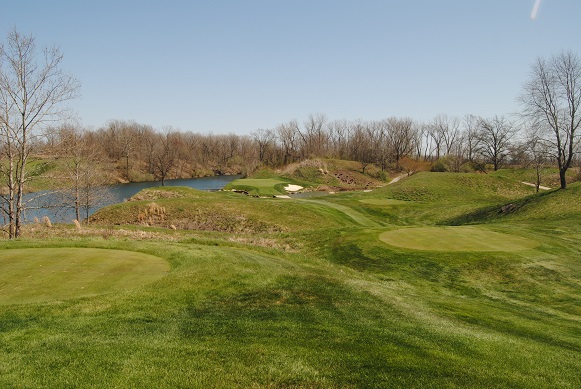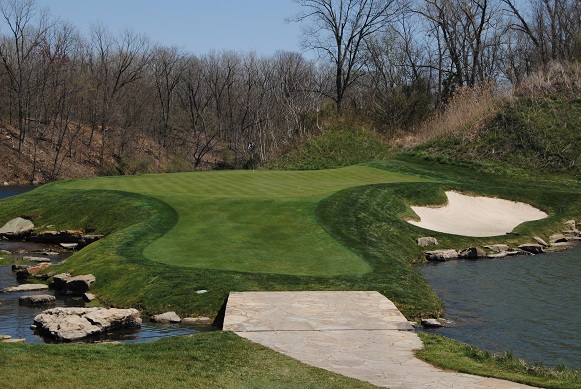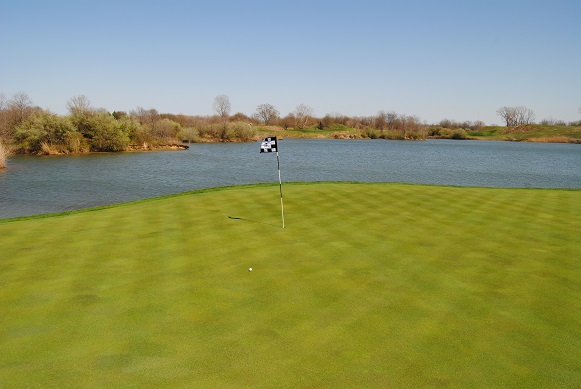The first time I talked with Tom Rose, the Director of Golf and Adam Lash, the Head Golf Pro at Victoria National Golf Club, it was clear that it was a place that welcomed guests. They told me that they were open year around and would welcome me to play the course at any time that fit in my schedule. I made a note of their flexibility and decided to keep an eye on the weather for a nice day in March or April. After all, it is in southern Indiana.
The day I chose to play the course turned out to be on a day with the nicest weather they’d had in Boonville, Indiana all year. From the moment I pulled up to the club in my rental car, I could tell that the welcoming spirit displayed over the phone by Tom and Adam permeated through the entire staff at Victoria National. The attendants were welcoming and attentive, Adam greeted me in the Pro Shop and gave me a tour of the clubhouse and locker room. Tom came out to greet me.
After talking with Tom and taking a tour with Adam, I was introduced to my caddie Corey. Corey had been a weekend only caddie at Victoria National, but had recently decided to take a break from his career and do more caddying. He grew up in the Philadelphia area, but later moved to Kentucky where he married. After a divorce he moved across the border to Indiana. He is also a budding entrepreneur. Corey worked in the banking industry where he invented a device that prevents skimmers from collecting information from cards when inserted into ATMs.
When I saw the name James on the back of his caddy bib, I thought we had the same last name. But, duh, I quickly realized that it designated him as my caddy. I felt like I was on the tour. At least the Web.com tour. Victoria National hosts an annual Web.com tour event which Corey caddies in. Today he was caddying for the Jimmie’s Top 100 Golf Course Tour as a part of my one year quest to play the Golf Digest 2017-18 Top 100 Golf Courses in America.
Corey joined me as I warmed up on the practice range. We then headed to the first tee. I chose to play from the Chinook tees. They measure just over 6400 yards with a rating of 73.5 and a slope of 142. This puts Victoria National in the upper range of difficulty.
The course opens with what should be an easy hole. It is a 388 yard par four that starts with a straight fairway of sufficient width that narrows as it approaches the green. There are rough covered moguls along both sides with deep rough after a few feet. There is just one fairway bunker. It’s on the left at 210 yards from the tee box. I sliced my drive to the deep rough on the moguls on the right side of the fairway.
It took Corey and me some time to find my ball, but we eventually found it sunk deep into the rough. Best I could do was to pitch the ball out to the fairway. I pulled my third shot to the left of the green into the rough on the moguls.
I left my first chip short of the green and then chipped on to four feet of the hole. I made the putt to open the round with a double bogey.
The second hole is a shorter but more difficult hole than the first. It’s a 323 yard par four with a water carry to a narrow undulated fairway that slopes from right to left. There are bunkers straight out on the right side of the fairway. I hit a three wood to stay short of the bunkers.
My tee shot left me with 140 yards to a back pin position on a green that curved left to right around a bunker off its right side. I hit a nine iron just slightly thin. The ball flew over the flag, landed on the green and rolled into the rough off the back of the green.
I chipped to 8 feet and made the putt for my first par of the round.
The third hole is 508 yard par five with water along the left that is in play off the tee, bunkers along the left in the landing zone and rough on slopes off the right side of a fairway that curves slightly to the right. The fairway ends at a green that is at a 90 degree angle. Corey gave me a line toward a tree on the right the right side of the fairway. I hit my drive 250 yards on that exact line.
The green is not visible from more than 80 yards out, but with a wide fairway that bends slightly to the right. There were no more bunkers in the play until the green. I decided to hit my driver off the deck for my second shot rather than lay up. I caught the ball cleanly, but it went straight rather than fading as would be expected with a driver off the deck. The ball landed in the rough on the down slope off the left side of the fairway.
I had a good lie but an awkward stance with the ball above my feet. The green was off to the right adjacent to a series of bunkers at the end of the fairway. I pulled my approach shot. The ball landed in the bunker closes to the green.
I hit out of the sand on the green. The ball rolled toward the cup and slide to six feet past. I made the putt for par.
The fourth hole is another short par four that is wrought with peril on both sides of a fairway that starts out aligned with the tee box then bends to the left. The fairway has lots of undulation and water on the left and two fairway bunkers on the right. The hole measures just 311 yards. I hit a 3 hybrid off the tee 210 yards to the left side of the fairway.
I had a straight shot of just under 100 yards to a green with a bunker off the right side and a back flag that was positioned left of middle. I pulled my short approach shot. The ball hit just off the left side of the green and kicked down the slope into the rough.
I pitched on to twelve feet. My par putt went into the cup and spun out leaving me with a bogey on a hole that should have been an easy par.
The fifth hole is a very challenging par three. It is almost an island green. It looks intimidating from the tee box. The green is shaped like a bicycle seat. It has water along the left, the right, and behind. There is a very narrow strip of land in front of the green that separates the water on the left and the right. There are also bunkers off the right side of the green and the left side of the green. I hit too much club. The hole measures 170 yards, but with a left to right wind, we thought it would play 180 yards. I hit a 5 iron that carried the green and went into the water behind the green.
I chipped on to 20 feet from the hole and missed the bogey putt. I made the next putt for a double bogey.
The 420 yard sixth hole is the number one handicap hole on the course. There is a carry over water and rough off the tee to a narrow right to left sloped fairway that winds its way to the green. There are no bunkers on the hole. Its length, fairway width, and deep rough are its only defense. I hit my drive to just inside the right edge of the fairway.
My approach shot faded too much and landed pin high in the rough off the right side of the green.
I pitched onto the green to 20 feet from the hole but missed the putt for par.
The par three seventh hole is less intimidating than the par three fifth hole. The hole measures 152 yards, has a carry over rough to a short fairway in front of the green. There is a bunker along the left side of the green. With the wind blowing right to left and the pin in the center on the front of the green, the hole was playing 140 yards. I pulled by tee shot into the left bunker. My sand shot landed on the green and rolled off the front of the green.
I putted from off the green to 10 feet and made the next putt for a bogey.
The eighth hole is a 391 yard par four. There is water that cuts into the left side of the fairway for the first seventy yards. A 200 yard carry from the Chinook tees easy gets beyond the water. Past the water the fairway is wider. There is a bunker off the right side of the fairway at 250 yards from the tee box. The fairway gets very narrow for the last 90 yards. I hit a monster drive that flew over 260 yards and then rolled another 40 yards.
I wish I knew how I did it because I’d like to do it every time. The ball stopped 85 yards from the pin which was positioned in the front middle portion of the green. The green has one bunker off the left side and two off the front right. I hit a lob wedge almost as well as I hit my driver. I did however catch the ball a little thin. The ball flew the green and landed in the rough.
I chipped on to 30 feet, missed the first putt and made the second one for a very disappointing bogey. Another case of proving that it is not how far you hit the ball, it’s how many times you hit it that count.
The front nine at Victoria National ends with a devilish par five. The shape of the hole is sort of like an index finger pointing back at you from the green to the tee box. The hole starts with a 130 yard carry over the rough. There are then three bunkers, one after another on the left side of the fairway for the next 100 yards. There is one off the right side at 210 yards out. The narrow fairway curves to the right and then bends back to the left. At 150 yards from the green a parallel fairway starts. There is a large bunker in the space between the two fairways. The fairways join at 50 yards out from the middle of the green. The green has water off the right side and off the back.
Fresh off my 300 yard drive on the eighth hole, I hit a 190 yard drive on this hole. At least the ball landed in the fairway.
Now I had a decision to make. Should I hit the ball to the left fairway or the right fairway. Hitting to the right fairway was easier but left a poor angle to the green. Hitting to the right fairway required a shot that carried at least 200 yards but left a better angle to the green for the approach shot. At 320 yards out, I chose to hit my driver off the deck to the right fairway. I hit a good shot, but the ball didn’t stay in the air for 200 yards. It landed in the rough to the right of the left fairway and short of the right fairway, leaving 130 yards to the flag.
This left the worse of all angles to the flag. There is a bunker on front of the green that can be avoided with a shot from the left or the right. I was left with a straight shot over the bunker. With a lot of room behind the flag, I chose to hit an extra club to the green. I cleared the bunker easily but was left with a 40 foot putt for birdie.
My putt traveled 40 feet but stopped a foot to the right of the hole. I tapped in to close out the front nine with a par and a 44 on the scorecard.
The back nine opens with a 506 yard par five. I started the back nine the same way I started the front nine – with an unnecessary double bogey. The hole has a nice wide fairway that bends slightly from right to left. It flows past a bunker off the left at 220 yards from the tee, another one off the right just across from that one and a final one on the right at 120 yards from the middle of the green. I popped my drive up, but it landed in the middle of the fairway.
I pushed my second shot to the dunes on the right side of the fairway.
I hit my third shot back to the fairway. My fourth shot landed in the front right bunker. I hit out of the sand to the green and two putted for the double bogey.
The 176 yard par three eleventh hole requires a carry over water that then runs along the left side of the green. There is a bunker between the water and the green. I hit my tee shot to the bunker.
My bunker shot landed just past the flag but rolled off the green. I putted from off the green. The ball skimmed the hole but didn’t drop. I tapped in for a bogey.
The twelfth hole is a short and easy par four. The fairway curves around water and a bunker off its left side that starts at about 200 yards from the tee and ends at 50 yards from the green. The hole is easy if you take advantage of the generous right side of the fairway. I hit a three hybrid to the middle of the fairway.
The pin was positioned at the back of the green. I missed the green to the right.
I chipped onto the green but left the ball 25 feet from the hole. I missed the par putt and made a three foot putt for bogey.
Things improved significantly for me starting with the 345 yard par four thirteenth hole. The hole plays fairly straight. There is water in front of the tee box, but its not in play. The only potential issue off the tee is a small bunker off the right side of the fairway at about 210 yards out. I hit my drive on a line just to the right of the fairway. It easily carried the bunker but landed in the rough leaving 120 yards to a middle pin.
My approach shot landed just short of the front of the green.
I putted just past the flag and made the comeback putt for my first par on the back nine.
My good fortune continued on the fourteenth hole where I made three bad shots and one good shot. The hole has water and a bunker off the left side of the fairway and trees and deep rough off the right side. The par four measures 406 yards. I hit my drive to the right rough. There were trees on a hill blocking my path to the green.
I tried to hit a fade around the trees, but the ball stayed straight and landed on the on the top of a ridge along the left side of the fairway and green.
I carry the ball too far onto the green with my pitch shot. The ball rolled off the green and into the rough.
Those were my three bad shots. All it took for a par on the hole was one good shot. I chipped in from the rough for the par.
From the tee box, the 530 yard fifteenth hole looks a whole lot more innocent than it is. The first part of the fairway is aligned with the tee box. It then doglegs to the right as it approaches a bunker on the right and water on the left. The water along the left continues to the green. The slight upslope in the fairway hides most of the view of the hole from the tee box. I hit my drive to the left side of the fairway, but the ball rolled across the fairway to the first cut of rough on the right. The rough prevented the ball from rolling into the fairway bunker.
At 270 yards from the green which is at a 90 degree angle to the fairway, I laid up with my second shot to 150 yards out, 20 yards more than I intended due to a stronger than expected wind.
After hitting my lay up 20 yards less than I expected and with water in front of the green, Corey and I agreed that I should hit two extra clubs on my approach shot. I hit my six iron directly at the flag. The ball stopped 20 feet below the flag.
Unfortunately, I didn’t convert. I missed my birdie putt and tapped in for my third par in a row.
The sixteenth hole is the final and most difficult of the par threes on the course. It’s another hole that looks intimidating from the tee box. There is a lot that could get in your head. There is water to the left and the right of the green, a creek running across the front, a bunker off the right side, and rocks all around. The green is long and narrow. The pin was set on the upper tier toward the back of the green. It’s best not to think about any of that. I hit my tee shot to the front of the green leaving a 50 foot putt to the flag.
I hit my putt much too hard. It rolled ten feet past the hole. I made the comeback 10 footer for my fourth par in a row.
The seventeenth hole is a 414 yard par four. The hole was playing into the wind. Water ran between the tee box and the fairway before turning left to run along the right side all the way to the right side of the green. The fairway which has a bunker off the right side, curves right to left, then back to the right before curving to the left again as it approaches the green. The water off the tee is only 160 yards and should have been carried easily. I turned it into a butt pucker when I got too steep on my drive and popped the ball up. The ball barely cleared the water, leaving 255 yards to the green.
At 255 yards out, water all along the right side of the fairway, trees and deep rough along the left side, and a strong wind in my face, I decided to lay up on my second shot. I hit the ball to 120 yards from the pin.
The green was positioned between a slope on the left and three bunkers on the right including a massive one off the front right corner. I hit my third shot to 15 feet left of the flag.
Corey gave me a great read for my par putt, but I left the ball one foot short of the cup. I picked the ball up and accepted the bogey to end my par streak.
Unfortunately, all good things must eventually come to an end. On this beautiful Spring day in southern Indiana, I approached the tee box of the finishing hole at Victoria National. The 18th hole is a 390 yard par four with a tee box that is aligned with the green, but with water in between and a boomerang shaped fairway that connects the two. There are two bunkers on the left just off the bend in the fairway. I took aim at the bunkers and hit what I thought was the perfect drive. You can imagine my disappointment when I reached the fairway and realized that my ball had landed in the fairway but rolled into the water off the right side.
I took a drop, hit my third shot to the left and short of the green. I chipped to eight feet left of the flag.
Sadly, I missed the bogey putt to end my round with a double bogey. I had made double bogeys on the 10th and the 18th hole. In between I played some good golf, but those two double bogeys left me with a 43, just one stroke better than the front nine. It felt like I’d played much better than my final score of 87.
I had a great time making the loop with Corey. I would like to thank Tom and Adam for accommodating me at Victoria National and for making my visit a great experience. The course was in great condition for the early season.





